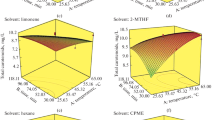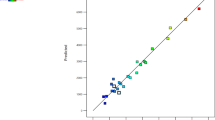Abstract
The total zeaxanthin level in Chlorella ellipsoidea, a green microalga, was more than nine times that of red pepper, a plant source of zeaxanthin. Additionally, the zeaxanthin in C. ellipsoidea consisted of the free form, while those in other plants exist as zeaxanthin mono- and diesters. Pressurized liquid extraction (PLE) was used to extract zeaxanthin from C. ellipsoidea. Both the extraction temperature and extraction time, the two main factors in PLE, were optimized with a central composite design to obtain the highest extraction efficiency of zeaxanthin. Hexane, ethanol, and isopropanol were used as PLE extraction solvents. Ethanol extracted zeaxanthin most efficiently from C. ellipsoidea. Temperature was the parameter with the strongest influence on the extraction of zeaxanthin. The optimum extraction temperature and time for zeaxanthin were 115.4°C and 23.3 min, respectively. The maximum predicted value of 4.28 mg g−1 agreed with the experimental value of 4.26 mg g−1, supporting the quality of the fitted model. These results indicate that PLE using ethanol may be a useful method for extracting zeaxanthin from C. ellipsoidea.


Similar content being viewed by others
References
Bhosale P, Larson AJ, Bernstein PS (2004) Factorial analysis of tricarboxylic acid cycle intermediates for optimization of zeaxanthin production from Flavobacterium multivorum. J Appl Microbiol 96:623–629
Cabrera T, Bae JH, Bai SC, Hur SB (2005) Comparison of the nutritional value of Chlorella ellipsoidea and Nannochloris oculata for rotifers and Artemia nauplii. J Fish Sci Technol 8:201–206
Cha KH, Koo SY, Lee DU (2008) Antiproliferative effects of carotenoids extracted from Chlorella ellipsoidea and Chlorella vulgaris on human colon cancer cells. J Agric Food Chem 56:10521–10526
Cha KH, Lee HJ, Koo SY, Song DG, Lee DU, Pan CH (2010) Optimization of pressurized liquid extraction of carotenoids and chlorophylls from Chlorella vulgaris. J Agric Food Chem 58:793–797
Chitchumroonchokchai C, Failla ML (2006) Hydrolysis of zeaxanthin esters by carboxyl ester lipase during digestion facilitates micellarization and uptake of the xanthophyll by caco-2 human intestinal cells. J Nutr 136:588–594
Cicchetti E, Chaintreau A (2009) Comparison of extraction techniques and modeling of accelerated solvent extraction for the authentication of natural vanilla flavors. J Sep Sci 32:1957–1964
Denery JR, Dragull K, Tang CS, Li QX (2004) Pressurized fluid extraction of carotenoids from Haematococcus pluvialis and Dunaliella salina and kavalactones from Piper methysticum. Anal Chim Acta 501:175–181
Ferruzzi MG, Blakeslee J (2007) Digestion, absorption, and cancer preventative activity of dietary chlorophyll derivatives. Nutr Res 27:1–12
Gouveia L, Nobre BP, Marcelo FM, Mrejen S, Cardoso MT, Palavra AF, Mendes RL (2007) Functional food oil coloured by pigments extracted from microalgae with supercritical CO2. Food Chem 101:717–723
Granano F, Olmedilla B, Blanco I (2003) Nutritional and clinical relevance of lutein in human health. Brit J Nutr 90:487–502
Guzmán S, Gato A, Calleja J (2001) Antiinflammatory, analgesic and free radical scavenging activities of the marine microalgae Chlorella stigmatophora and Phaeodactylum tricornutum. Phytother Res 15:224–230
Halperin S, Smith B, Nolan C, Shay J, Kralovec J (2003) Safety and immunoenhancing effect of a Chlorella-derived dietary supplement in healthy adults undergoing influenza vaccination: randomized, double-blind, placebo-controlled trial. Can Med Assoc J 169:111–117
Hatano S, Kabata K, Yoshimoto M, Sadakane H (1982) Accumulation of free fatty acids during hardening of Chlorella ellipsoidea. Plant Physiol 70:1173–1177
Herrero M, Martin-Alvarez PJ, Senorans FJ, Cifuentes A, Ibanez E (2005) Optimization of accelerated solvent extraction of antioxidants from Spirulina platensis microalga. Food Chem 93:417–423
Herrero M, Jaime L, Martin-Alvarez PJ, Cifuentes A, Ibanez E (2006) Optimization of the extraction of antioxidants from Dunaliella salina microalga by pressurized liquids. J Agric Food Chem 54:5597–5603
Higashi-Okai K, Otani S, Okai Y (1998) Potent suppressive activity of pheophytin a and b from the non-polyphenolic fraction of green tea (Camellia sinensis) against tumor promotion in mouse skin. Cancer Lett 129:223–228
Itoh N, Numata M, Aoyagi Y, Yarita T (2008) Comparison of low-level polycyclic aromatic hydrocarbons in sediment revealed by Soxhlet extraction, microwave-assisted extraction, and pressurized liquid extraction. Anal Chim Acta 612:44–52
Jaime L, Rodriguez-Meizoso I, Cifuentes A, Santoyo S, Suarez S, Ibanez E, Senorans FJ (2009) Pressurized liquids as an alternative process to antioxidant carotenoids' extraction from Haematococcus pluvialis microalgae. LWT Food Sci Technol 43:105–112
Kitada K, Machmudah S, Sasaki M, Goto M, Nakashima Y, Kumamoto S, Hasegawa T (2009) Supercritical CO2 extraction of pigment components with pharmaceutical importance from Chlorella vulgaris. J Chem Technol Biotechnol 84:657–661
Lanfer-Marquez UM, Barros RMC, Sinnecker P (2005) Antioxidant activity of chlorophylls and their derivatives. Food Res Int 38:885–891
Macias-Sanchez MD, Mantell C, Rodriguez M, de la Ossa EM, Lubian LM, Montero O (2009) Comparison of supercritical fluid and ultrasound-assisted extraction of carotenoids and chlorophyll a from Dunaliella salina. Talanta 77:948–952
Mendiola JA, Herrero M, Cifuentes A, Ibanez E (2007) Use of compressed fluids for sample preparation: food application. J Chromatogr A 1152:234–246
Mizoguchi T, Takehara I, Masuzawa T, Saito T, Naoki Y (2008) Nutrigenomic studies of effects of Chlorella on subjects with high-risk factors for lifestyle-related disease. J Med Food 11:395–404
Nakano S, Takekoshi H, Nakano M (2007) Chlorella (Chlorella pyrenoidosa) supplementation decreases dioxin and increases immunoglobulin a concentrations in breast milk. J Med Food 10:134–142
Okai Y, Higashi-Okai K (1997) Potent anti-inflammatory activity of pheophytin a derived from edible green alga, Enteromorpha prolifera (Sujiao-nori). Int J Immunopharmacol 19:355–358
Rodriguez-Amaya DB, Kimura M (2004) Harvestplus handbook for carotenoid analysis. HarvestPlus, Washington
Rodriguez-Meizoso I, Jaime L, Santoyo S, Cifuentes A, Reina GGB, Senorans FJ, Ibanez E (2008) Pressurized fluid extraction of bioactive compounds from Phormidium species. J Agric Food Chem 56:3517–3523
Sansawa H, Endo H (2004) Production of intracellular phytochemicals in Chlorella under heterotrophic conditions. J Biosci Bioeng 98:437–444
Schumann R, Haubner N, Klausch S, Karsten U (2005) Chlorophyll extraction methods for the quantification of green microalgae colonizing building facades. Int Biodeter Biodeg 55:213–222
Weller P, Breithaupt DE (2003) Identification and quantification of zeaxanthin esters in plants using liquid chromatography–mass spectrometry. J Agric Food Chem 51:7044–7049
Zaibunnisa AH, Norashikin S, Mamot S, Osman H (2009) An experimental design approach for the extraction of volatile compounds from turmeric leaves (Curcuma domestica) using pressurised liquid extraction (PLE). LWT Food Sci Technol 42:233–238
Acknowledgments
This research was financially supported by the Ministry of Education, Science and Technology (MEST), Gangwon Province, Gangneung City, Gangneung Science Industry Foundation (GSIF) as the R&D Project for Gangneung Science Park promoting program.
Author information
Authors and Affiliations
Corresponding author
Additional information
Song Yi Koo and Kwang Hyun Cha contribute equally to this work.
Rights and permissions
About this article
Cite this article
Koo, S.Y., Cha, K.H., Song, DG. et al. Optimization of pressurized liquid extraction of zeaxanthin from Chlorella ellipsoidea . J Appl Phycol 24, 725–730 (2012). https://doi.org/10.1007/s10811-011-9691-2
Received:
Revised:
Accepted:
Published:
Issue Date:
DOI: https://doi.org/10.1007/s10811-011-9691-2




